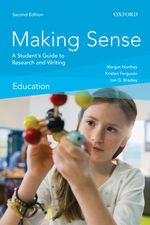| ________________
CM . . .
. Volume XXIV Number 8. . . October 27, 2017
excerpt:
Making Sense: Education: A Student’s Guide to Research and Writing is part of the Oxford University Press’ “Making Sense” series – a series of disciplinary academic writing guides. Judging by its cover, one initially thinks this is intended for high school teachers who are teaching their students how to research and write. However, as explained in the preface, it is in fact a volume “aimed at elementary and secondary school teachers” and examines “the unique writing world and point of view of the teacher” and “reinforces standard notions of professional writing”. Written by well-qualified academics, this publication does fulfill a niche as, to my knowledge, there are very few titles that offer up practical writing tips for teachers. Within 273 pages, there are 15 chapters starting with four that outline the importance of writing in education and then moving on to the essay, professional summary, critiques and reviews, literature review and writing of formal letters, newsletters, emails, and other reports. Each chapter begins with its objectives, introduction, writing content and then concludes with references. The information is clearly presented and easy-to-read. The only problem is that the advice given is very basic and lacks rich and specific educational contexts that would have helped elucidate the content and have been of greater application professionally. More exemplars, for instance, would have helped demonstrate exactly what an effective professional summary or a short academic critique should look like. Moreover, if the examples had included common educational content studied within education courses, then they would have been especially useful for pre-service teachers. Similarly, in the chapter on professional communiques, general guidance was included about letters, newsletters and emails. There is no question that these are important forms of teacher communication. However, the sample letter included was limited to that of seeking sponsorship. Other more useful examples could have included letters sent home to parents regarding upcoming instruction or welcome letters to parents introducing themselves as teachers. The practical tips though about writing newsletters were sound. Blogs were included as part of newsletter writing. However, given the popularity of blogs as a way for teachers to communicate with students and parents, more time should have been devoted to blogs and, in particular, about effective ways of organizing and crafting clear blog posts. Chapters 5 to 10 covered basic writing elements such as how to use tables and figures, how to cite or document sources, and on writing style, grammar, punctuation, and misused words and phrases. Written in a straightforward manner, these chapters offered valuable information. However, since over a 100 pages was devoted to this content and most of it was not specific to education, in my estimate, readers could easily have been referred to a good writing handbook or a series of websites instead. The last four chapters were the most important. In Chapters 11 to 15, specific writing contexts critical for beginning teachers included: conducting effective oral presentations, engaging in active listening and group work, applying for jobs with precise curricula vitae and well-written cover letters, creating education portfolios and reflective writing, and finally curriculum planning and reporting of student work. Of most use was the information provided about oral presentations, empathetic listening and steps in backwards design. However, these clearly structured chapters were disappointing as again they lacked depth and enough illustrative examples of the ideas and concepts. More detail was necessary and would have been especially valuable given how clearly the authors write. Appended at the end of the book, are “Online Resources for Educators”, and these refer the reader to very valuable sources. Overall, Making Sense: Education: A Student's Guide to Research and Writing may be a potential purchase for an Education Library collection and specifically for use with pre-service teachers whose knowledge of writing is very weak. Unfortunately, I would hesitate to recommend it as a valuable read for most pre-service or practicing teachers and cannot imagine that they would persist in reading it in its entirety. Recommended with Reservations. Jo-Anne Naslund is the Instruction Programs Librarian in the Education Library at the University of British Columbia.
To comment
on this title or this review, send mail to cm@umanitoba.ca.
This Creative Commons license allows you to download the review and share it with others as long
as you credit the CM Association. You cannot change the review in any way or use it commercially. Commercial use is available through a contract with the CM Association. This Creative Commons license allows publishers whose works are being reviewed to download and share said CM reviews provided you credit the CM Association.
Next Review | Table of Contents For This Issue - October 27, 2017 |
